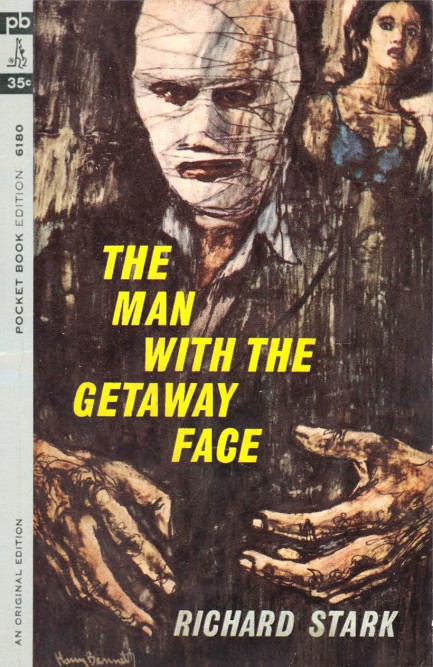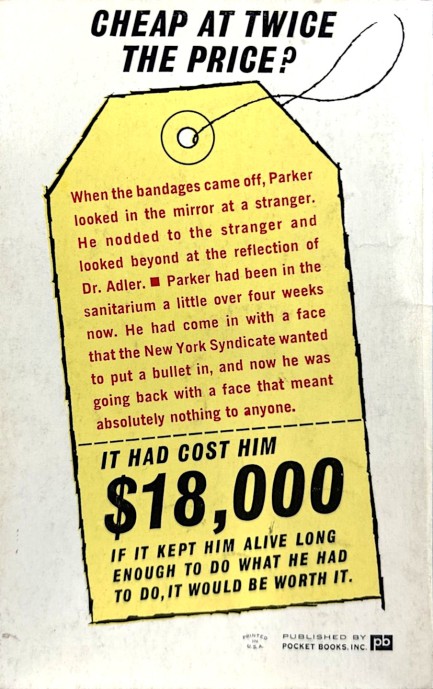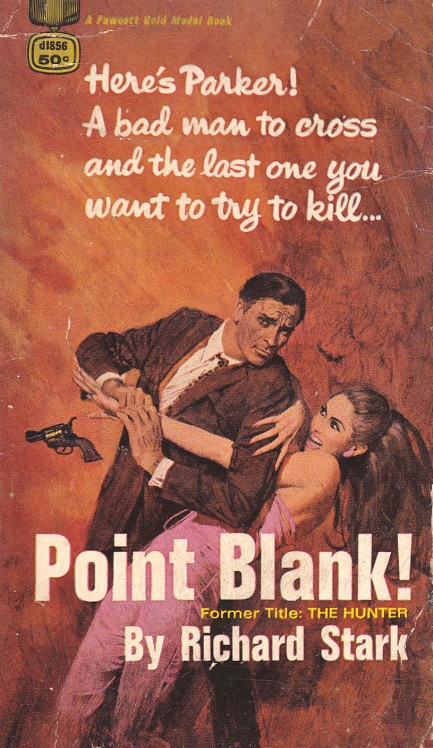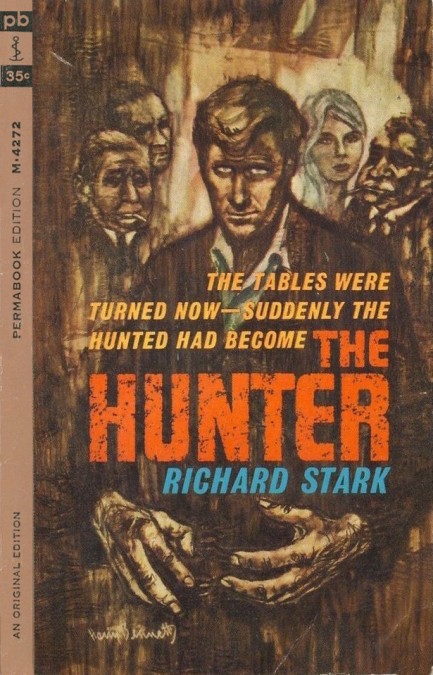 He can run from the past but he can't hide.  
It took us a while but we've returned to Richard Stark, aka Donald E. Westlake, and his Parker series. We read entry one a few years ago. 1963's The Man with the Getaway Face is number two. The cover art here is by Harry Bennett and he basically copied his cover for book one, but changed the background and added the facial bandages. Those bandages reveal the premise—Parker has had a cosmetic surgeon change his face in order to help him evade “the Outfit,” who owe him in spades for various transgressions.
But Getaway Face doesn't focus on Parker's pursuers. Clearly, that's coming in the future. In the here and now he needs money, so he signs onto an armored car robbery, which, in adherence to the pulp law of tenuous connections turning into huge problems, boomerangs in such a way that his face doctor is murdered and Parker is blamed for it. His hands are full: deadly enemies, armed robbery, betrayal, murder, pursuit, and revenge. But he has very big hands. Nice work. We'll read book number three in the series soon.
 You think you're the first spurned woman to try shooting me? Baby, that's how my ex-girlfriends all say hello. 
Above is the Fawcett Publications 1967 edition of Richard Stark's, aka Donald E. Westlake's landmark crime thriller Point Blank, which was originally published in 1962 as The Hunter and was first in the long-running Parker series. Parker was one of the cruelest and most sociopathic anti-heroes in mid-century literature. The Robert McGinnis cover makes him look like some kind of sophisticated rogue, but don't let the art fool you—Point Blank is rough stuff. You like Jack Reacher? Reacher has the personality of a yoga instructor in comparison. This was our first Parker, and it looks like we're going to have a long, entertaining relationship with this character.
 To a true hunter everyone is prey. 
Richard Stark's, aka Donald E. Westlake's The Hunter, which was also published as Point Blank, is a landmark in crime literature, a precursor to characters like Jack Reacher. The standout qualities of this novel are its brutality and its smash cuts from set-piece to set-piece. As an example of the former, the main character, named Parker, basically scares a woman into committing suicide, dumps her body in a park, and slashes her face post-mortem as a way of foiling police attempts at identification. The latter quality, the narrative's disorienting transitions, is exemplified by a chapter that ends with Parker's hands mid-murder around an enemy's throat, and the next opening with him sitting in another enemy's house, holding a gun on him as he walks through the door. Westlake stripped away every bit of transitional prose he could in order to create breakneck pacing and heightened menace. Parker is not only dangerous, but is also emotionally barren. He feels nothing beyond the need to best his rivals. Permanently. Westlake's publisher knew The Hunter was something special, and convinced him to turn what was supposed to be a stand-alone novel into a series. Twenty-four entries in that series speak to its success. This first of the lot is highly recommendable. It came from Perma Books in 1962, and the excellent cover art featuring Parker's lethally large hands is by Harry Bennett.
|
 |

The headlines that mattered yesteryear.
1939—Batman Debuts
In Detective Comics #27, DC Comics publishes its second major superhero, Batman, who becomes one of the most popular comic book characters of all time, and then a popular camp television series starring Adam West, and lastly a multi-million dollar movie franchise starring Michael Keaton, then George Clooney, and finally Christian Bale. 1953—Crick and Watson Publish DNA Results
British scientists James D Watson and Francis Crick publish an article detailing their discovery of the existence and structure of deoxyribonucleic acid, or DNA, in Nature magazine. Their findings answer one of the oldest and most fundamental questions of biology, that of how living things reproduce themselves. 1967—First Space Program Casualty Occurs
Soviet cosmonaut Vladimir Komarov dies in Soyuz 1 when, during re-entry into Earth's atmosphere after more than ten successful orbits, the capsule's main parachute fails to deploy properly, and the backup chute becomes entangled in the first. The capsule's descent is slowed, but it still hits the ground at about 90 mph, at which point it bursts into flames. Komarov is the first human to die during a space mission. 1986—Otto Preminger Dies
Austro–Hungarian film director Otto Preminger, who directed such eternal classics as Laura, Anatomy of a Murder, Carmen Jones, The Man with the Golden Arm, and Stalag 17, and for his efforts earned a star on Hollywood's Walk of Fame, dies in New York City, aged 80, from cancer and Alzheimer's disease. 1998—James Earl Ray Dies
The convicted assassin of American civil rights leader Martin Luther King, Jr., petty criminal James Earl Ray, dies in prison of hepatitis aged 70, protesting his innocence as he had for decades. Members of the King family who supported Ray's fight to clear his name believed the U.S. Government had been involved in Dr. King's killing, but with Ray's death such questions became moot.
|

|
|

It's easy. We have an uploader that makes it a snap. Use it to submit your art, text, header, and subhead. Your post can be funny, serious, or anything in between, as long as it's vintage pulp. You'll get a byline and experience the fleeting pride of free authorship. We'll edit your post for typos, but the rest is up to you. Click here to give us your best shot.

|
|











































































